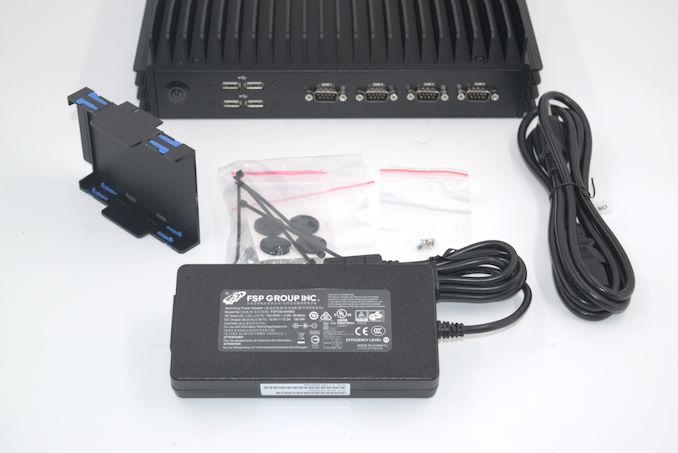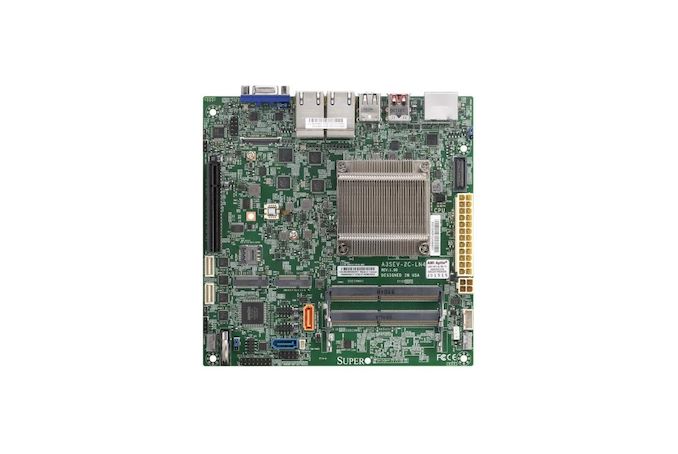Supermicro SYS-E302-12E Fanless Industrial PC Review: Elkhart Lake for IoT Applications
by Ganesh T S on March 10, 2023 8:00 AM EST- Posted in
- Systems
- Fanless
- Supermicro
- Passive Cooling
- Elkhart Lake

Passively-cooled systems find application in a wide variety of industrial use-cases including automation, IoT gateways, medical systems, surveillance, and digital signage. In addition to avoiding moving parts, systems meant for industrial use need to be built to operate 24x7 in challenging environmental conditions.
Supermicro has systems targeting this market under the Embedded / IoT category in a variety of form-factors. Scenarios with minimal I/O requirements can use the compact chassis with support for 3.5" SBCs. The company also provides passively-cooled chassis configurations for industrial mini-ITX boards.
The Supermicro SYS-E302-12E based on the Intel Atom x6425E embedded SoC is the company's highest performing system in the Elkhart Lake lineup. It is optimized for industrial automation, digital signage / data visualization, and IoT applications. The review below takes a detailed look at the features and performance profile of the system, along with an evaluation of the thermal solution.
Introduction and Product Impressions
Supermicro's SYS-E302-12E is based on the Super A3SEV-4C-LN4 mini-ITX board. The board is available for purchase with an integrated heatsink. Supermicro also offers the SYS-E302-12E barebones system based on this board by removing the heatsink and mounting the board inside the CSE-E302iL2 passively-cooled chassis.
Intel's Tremont microarchitecture for low-cost processors has been available in the market for a few years now in Jasper Lake-based systems meant for use as entry-level PCs. Processors meant for the embedded market (such as the Elkhart Lake SoCs) make it to end customers much later than their consumer counterparts - they have a long life-cycle, and lengthy qualification cycles too. Even though Elkhart Lake-based consumer systems are already trickling into the market, the ones based on embedded SKUs such as the Atom x6425E are becoming widely available only now.
The SYS-E302-12E is marketed as an IoT SuperServer, but it doesn't have a separate BMC and also does not support ECC memory. However, the embedded SKU officially supports in-band ECC. We have already evaluated the impacts of in-band ECC on performance in our Raptor Lake-P review. Unfortunately, the BIOS version currently available for the SYS-E302-12E doesn't have the option to toggle in-band ECC, but Supermicro confirmed that an upcoming release would enable that option.
Supermicro has equipped the SYS-E302-12E with a wide range of I/O interfaces - four RS232 COM ports, four gigabit LAN ports, six USB 2.0 ports, and two USB 3.2 Gen 2 ports. There are three display outputs, and there is space available inside the chassis to install a 2.5" SATA drive also.
In addition to the main unit, Supermicro supplies a lockable 150W (12V @ 12.5A) adapter, AC power cord, 2.5" drive caddy, appropriate screws, and cable ties in the package.
Our review sample included 2x 16 GB DDR4-2666 SODIMMs as well as a 256 GB InnoDisk M.2 SATA drive. The full specifications of the review sample are provided in the table below.
| Supermicro SYS-E302-12E Specifications (as tested) |
|
| Processor | Intel Atom x6425E Elkhart Lake 4C/4T, 2.0 - 3.0 GHz Intel 10, 1.5 MB L2, 12 W |
| Memory | Innodisk M4SI-AGS1O50K-C DDR4-2666 SODIMM 19-19-19-43 @ 2666 MHz 2x16 GB |
| Graphics | Intel UHD Graphics for 10th Gen Intel Processors (32EU @ 500 MHz) |
| Disk Drive(s) | Innodisk M.2 (S80) 3TE7 DEM28-B56DK1EW1QF (256 GB; M.2 2280 SATA III;) (64L 3D TLC; InnoDisk ID301 Controller) |
| Networking | 1x GbE RJ-45 (Intel I210-IT) 3x GbE RJ-45 (Intel EC1000S MAC + Marvell Alaska 88E1512 PHY) |
| Audio | Realtek ALC888S Audio Codec On-board (Optional Audio Jack, N/A in Review System) Audio Bitstreaming Support over HDMI Ports |
| Video | 1x HDMI 2.0b 1x DisplayPort 1.4 1x VGA (via eDP from SoC) |
| Miscellaneous I/O Ports | 2x USB 3.2 Gen 2 Type-A (Rear) 2x USB 2.0 Type-A (Rear) 4x USB 2.0 (Front) 4x RS-232 COM (Front) |
| Operating System | Windows 11 Enterprise (22000.1335) |
| Pricing | (Street Pricing on March 9th, 2022) US $894 (Barebones) US $1315 (as configured, no OS) |
| Full Specifications | Supermicro SuperServer SYS-E302-12E Specifications |
The system is available for purchase from WiredZone for $894 by manufacturer drop-ship. Supermicro is still in the process of expanding retail availability.
The SYS-E302-12E is a bit of a unique system compared to the embedded / industrial PCs we have reviewed earlier. For starters, it is one of the first systems to officially support in-band ECC. The wealth of network ports and other communication options is not matched by any other low-power fanless system we have covered earlier. The chassis also appears to be a massive overdesign for a 12W TDP SoC - keen observers might have noticed that it is the same one that successfully handled a 60W TDP Xeon-D in the SuperServer E302-9D. We can expect the thermal performance to be top-notch and allow the system to operate in a wide temperature range.
The top view of the motherboard integrated in the system is show above. The heatsink shown is replaced by a solid metal block that tightly interfaces with the chassis top using a thermal pad. The M.2 SATA port and SODIMMs are easily accessible, but the x8 PCIe slot is not usable in the system (the space meant for the PCIe add-in card is instead allocated to the 2.5" drive tray).
In the next section, we take a look at the system setup and provide some analysis of the platform.













16 Comments
View All Comments
PeachNCream - Monday, March 13, 2023 - link
It was common for OEMs to not actually deliver 75W to a PCIe slot in times past. I'm not as familiar with this stuff now because desktop systems aren't as commonplace, but its always possible to push like 35W to a slot in a space constrained system like that one.Matthias265 - Friday, March 31, 2023 - link
the largest brick Supermicro has is 180Wdeil - Thursday, March 16, 2023 - link
Well, top efficiency is around 75% so it's already 120W, now include all the USB powered devices that come from it, and remember that intel saying 12W means 50W turbo....disable turbo and disconnect all extra devices, and it should run from 30W phone charger.
Matthias265 - Friday, March 31, 2023 - link
hello, yes this necessary for 2 reasons,for the system needs also power fur DRAM, chipset, SSD, USB, PCIe, etc
allowance for the PICe is 65W
also the new CPU have a TPW or 12W, but they draw much higher current during turbo mode,
that's only for a short time, however the power supply must be able to supply 2x to 3x the TDP of the CPU
mode_13h - Saturday, March 11, 2023 - link
I can't help but be disappointed by both the idle & active power. And, in spite of that, it's a little disheartening to see it fall so far behind the N6005.In-band ECC support will be the lone bright spot. However that's coming so late that I'm already looking towards Alder Lake-N.
Hrel - Tuesday, April 11, 2023 - link
A THOUSAND Dollars?! For a computer that couldn't even decode HD video? I could see a use for a system like this but every use case I can imagine couldn't justify more $300 at the absolute max. Who's intended to buy this?